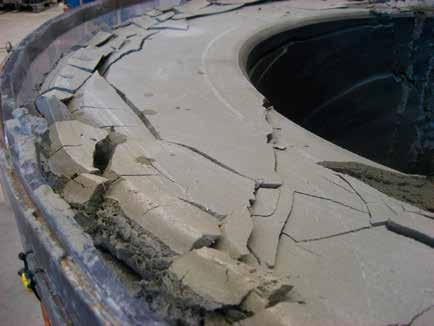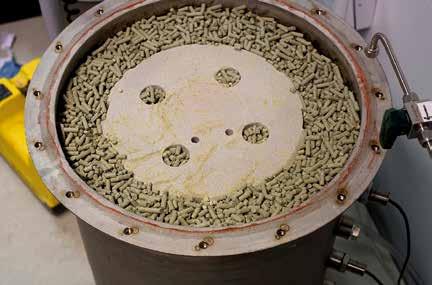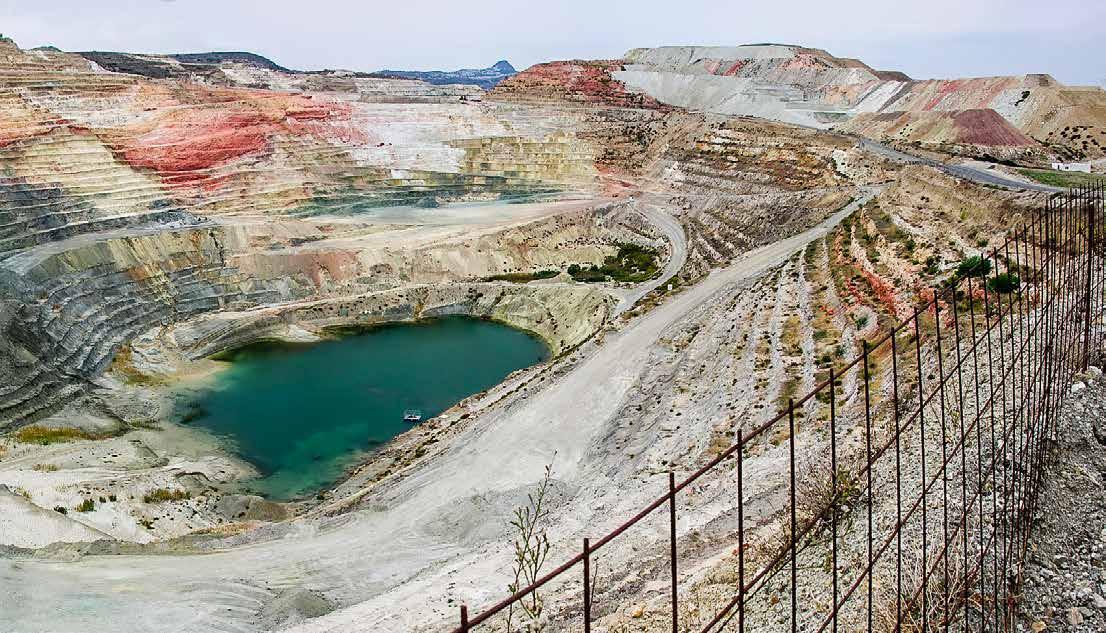
9 minute read
BEACON
A full scale model of the Swiss High-Level Waste (HLW) disposal concept with the waste inside a steel canister on top of blocks of bentonite and surrounded by bentonite pellets © Comet Photoshopping GmbH, Dieter Enz
Patrik Sellin of the BEACON project explains why modelling the performance of bentonite’s mechanical behaviour, will mean predictive models will benefit engineers and satisfy regulators by understanding how it can be used as an effective sealant, in nuclear waste repositories.
Bentonite is an absorbent clay substance, possessing qualities which make it useful for very specific applications. Made up of natural materials, it is used in many sectors, for everything from cosmetics to cat litter. Crucial, for those tasked with disposing of nuclear waste safely, it will be used for creating a natural seal for engineered barriers in geological repository concepts, as it expands into voids when you add water to the mix.
In this respect, the Beacon project has been studying bentonite’s mechanical properties in the context of being a barrier for repositories containing radioactive waste, where it is critical to ensure effective seals are in place indefinitely. Engineered Barrier Systems (EBS) are repositories designed to hold radioactive waste for hundreds of thousands of years. They vary in design around the world, all with the purpose of creating a leak-proof, sealed containment system within the ground. Implicitly understanding the sealing abilities to these systems is key to having confidence that they are meeting their requirements.
Water content of the bentonite buffer of the Febex experiment after 18 years of saturation. © McKie/Nagra
Barrier science for Radioactive Waste Management
“Bentonite is used as a seal, and a buffer. Bentonites have been stable for millions of years in nature, so it’s something that we can rely on for long term stability,” begins Patrik Sellin, co-coordinator of the Beacon project, whose experience derives from working in an expert capacity for SKB, Swedish Nuclear Fuel and Waste Management Co. “It acts like a sponge and it keeps the water intact, in the system, which means that all water transport through this engineered barrier will be very, very limited. This is the basis of this project, how to show that we have put in something that is engineered into a rock cavity and then after water saturation it gets to have

the properties that we want it to have, low water permeability is the main factor here. You don’t want the ground water to go through the barrier and since this is a mixture of bentonite blocks and pellets and also voids, for Beacon, it is to see after the water uptake, what the final properties of this barrier will be. What we want to show is that it is sufficiently homogeneous.”
For high level radioactive waste systems, all the relevant programmes are still in the planning stage. Beacon relied on a banquet of data available from previous practical experiments around repositories, using that data as a means to test and create accurate, predictive mathematical modelling. It proved cost efficient and highly effective to use abundant existing data rather than to produce new data. This was in fact the first time this data was used in mathematical modelling in this way.

Predicting performance
“There are quite a few experiments available from the past, field experiments in underground laboratories, that looked at bentonite swelling but the experiments have not been evaluated in a way that people can predict them, and what we need, if we want to license a repository, is to have models that can predict the performance of an installed barrier, because you cannot test the barrier or material, or buffer after the repository has been backfilled or sealed. The Beacon project is about the more subtle performance of the bentonite barriers,” said Sellin.
The work’s aim has been to intricately understand the soil mechanics involved and the design performance of these barriers, so engineered systems are futureproof for regulators wanting confidence in designs of EBS’s that remained sealed over time. Regulators may need provable assurances in
Bentonite quarry KBS3 koncept – three engineered barriers: the canister, the bentonite buffer (and backfill) and the rock. © SURAO
barrier effectiveness, so testable modelling is a way to truly understand the intricacies of how bentonite reacts, expands, and fills void dimensions.
“Regulators will probably ask us at some point, ‘how homogenous will it actually be?’” predicts Sellin. “We have seen in certain instances the homogeneity has been not so good and in other tests it’s been very good, so this means that it’s not an issue you can
Filling in the gaps
The Beacon consortium involves over 30 collaborating organisations and partners, large and small, from across Europe, which
initially had varying levels of understanding about the mechanics of bentonite. This group or organisations includes an effective mix of radioactive waste management programmes, national research centres, innovative SMEs and civil society non-governmental organisations. It became apparent from the very first test case, in work package five, that to replicate accurate mechanical modelling would be far more challenging than anyone initially anticipated, making the project’s relevance all the more apparent.
drop, you have to understand your system to be able to design your barriers and to show and demonstrate that they fulfil their requirements.
“Our work is to demonstrate that we understand the homogeneity of the barriers. What we need is to understand the properties of our barriers in the repository and that we are able to predict them. We need to do this as we will not be able to control it after the closure of the repositories. We need to understand this water uptake saturation process, which may take hundreds of thousands of years. It’s definitely not possible to change the state of the barrier after full saturation so that is why we need tools that are predictive for these types of questions.”



Bentonite pellets (bottom) and bentonite compacted block (top) hydrated from the bottom: evolution of appearance. Photos by Rubén J. Iglesias © CIEMAT
In the test, different research teams were given the same task. Researchers attempted to detect a very simple swelling of bentonite in a cylinder 50mm high. The bentonite sample was 40mm high and they added water and it was supposed to expand into the remaining 10mm. Despite the basic nature of this small experiment, what occurred drove a deeper understanding of not what was known, but what was not known.
“Incredibly, all the teams came up with totally different results!” exclaimed Sellin. “No one could predict it and we thought that this was very simple, but it wasn’t, and this stage of mechanical modelling and the deviation in this project wasn’t expected. The further we progressed into the project, however, the modelling cases people came up with had much better results because it’s a learning curve around conceptual ideas and mathematical solutions. So, this very first test case in work package five was extremely challenging – much more than we thought. Some overpredicted and some underpredicted but the results were not consistent as everyone was off in different ways.”
The power of collaborating and coordination between researchers became a driver for significant improvement for everyone involved, levelling the comprehension between groups and improving the accuracy of predictions.
Bentonite components need careful and humidity regulated conditions before and under installation. Cracked bentonite buffer block. © SKB

Experimental set up with a bentonite block and extruded bentonite pellets around it. © SKB
“We ensured people could talk to each other and help each other toward better solutions to these problems. If you do this all by yourself, you may hit a dead-end because your thinking is limited by one person or group, but if you have many groups talking to each other, they can help each other in different areas. One idea around this project is to help less developed programmes, in this respect. We have since seen that groups at their beginning of this, are now at the level of the more experienced programmes.”
All participating waste management organisations agreed that developing accurate modelling tools, understanding material properties, the water saturation processes that lead to homogenisation and the scale effects, would prove very useful for design and engineering purposes in radioactive waste management.
As Sellin concluded, “We need something that can be trusted both now and in the future.”

Bentonite Mechanical Evolution Project Objectives
The sealing ability is essential for the engineered clay (bentonite) barriers in all geological repository concepts. The overall objective of the Beacon project is to develop and test the tools necessary for the assessment of the mechanical evolution of an installed bentonite barrier and the resulting sealing ability of the barrier.
Project Funding This project receives funding from the Euratom research and training programme 2014-2018 under grant agreement No 745942 Project Partners
• SKB, Sweden • RAWRA/SURAO, Czech Republic • POSIVA, Finland • ANDRA, France • NAGRA, Switzerland • ENRESA, Spain • RWM/NDA, United Kingdom • MKG, Sweden • UPC, Spain • GRS, Germany • CTU, Czech Republic • CUNI, Czech Republic • CEA, France • VTT, Finland • ULG, Belgium • BGR, Germany • KIT, Germany • LEI, Lithuania • CIEMAT, Spain • CLAY, Sweden • EPFL, Switzerland • ICL, United Kingdom • QUINTESSA, United Kingdom • NERC/BGS, United Kingdom • JYU, Finland / Expert Advisory and Review Board: IRSN • FANC • TU Clausthal • PSI • SSM
Contact Details
Mary Westermark, Project Manager SVENSK KÄRNBRÄNSLEHANTERING AB Evenemangsgatan 13, Box 3091, SE-169 03 Solna, Sweden T: +46 8 459 84 20 E: beacon@skb.se W: https://www.beacon-h2020.eu
Mary Westermark Patrik Sellin
Mary Westermark is the Primary Coordinator Contact and administrative coordinator for the Beacon project. She is certified PMI PMP and has a long experience in managing and coordinating projects, and employed at the Swedish Nuclear Fuel and Waste Management Co (SKB). At the moment she is also managing e g a project in regarding development of bentonite clay backfill installation equipment at SKB, she was WP leader and Primary coordinator contact of BELBaR, is main participant contact for DOPAS and has been involved in the management of LUCOEx, all earlier EU-projects.
Patrik Sellin is the scientific and technical coordinator of Beacon. He is a civil engineer, specialized on clay materials and has worked at Swedish Nuclear Fuel and Waste Management Co (SKB) since 1988. He is manager of the R&D programme for buffer and backfill long-term performance. He has been scientific coordinator and WP leader of the 7th framework BELBaR and WP leader of e.g. PEBS and Forge, all earlier EU-projects on bentonite clay.











